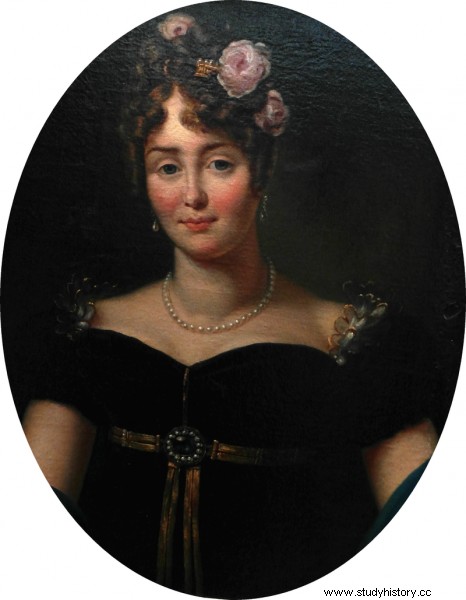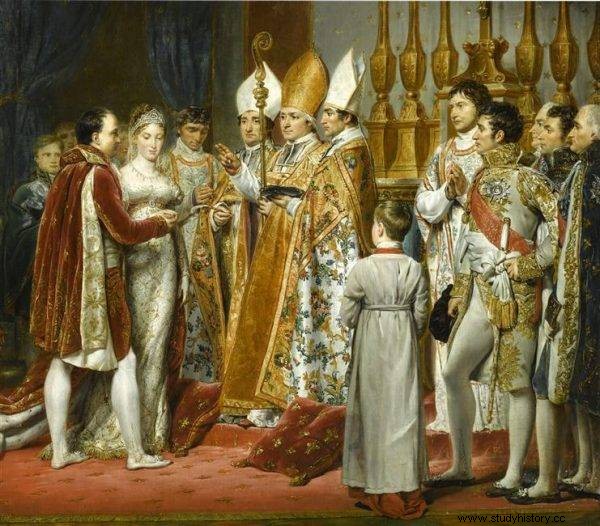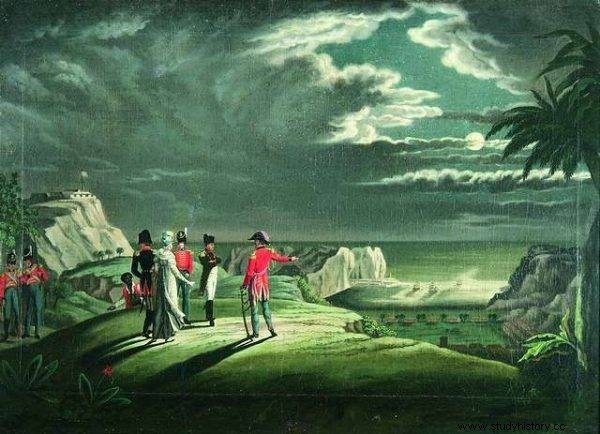When in April 1814 the defeated Napoleon went to exile on the island of Elba, he expected his wife Maria Ludwika to join him. He was very disappointed. But instead Maria Walewska came to the island.
Napoleon himself, although he was happy about this visit, was heartbroken because of the adultery of his wife, whom he truly loved. For Poles, the presence of their former mistress on Elba testified to the fact that Bonaparte and Maria still had a deep relationship. This further strengthened the myth of the brave Walewska, who had a huge impact on the French Emperor and even had her share in the establishment of the Duchy of Warsaw.
Maria Walewska - legends and reality
There is a romantic version of the beginning of this relationship. It says that the future lovers first saw each other at the Jabłonna post station in 1807, during Napoleon's trip to Warsaw. The emperor's carriage stopped for a short rest.
"Heavy snow was falling, but soon a large crowd of people welcomed him around the carriage - Christopher Hibbert describes this event - There was also an exceptionally beautiful blonde girl among them a young woman in a fur coat, whom [Napoleon] mistook for a peasant woman, until she spoke to General Duroc in good French asking him to introduce her to the man who promised to liberate Poland and defeated Austria, Prussia and Russia, the oppressors of her country ”. Bonaparte gave her a bouquet of flowers which was thrown into the carriage as soon as he opened the window. When Maria thanked for the gift, she reportedly announced:"I will steal the thanks from your beautiful lips!"
Napoleon commissioned his subordinates to establish the identity of the young lady. It turned out that her name is Maria, she is 18 years old and has a little son. She is the third wife of 72-year-old Count Anastazy Colonna Walewski, whom she married to avoid a scandal after becoming pregnant. The infatuated Napoleon invited the woman to a ball in Warsaw.

Walewska and Napoleon spent 3 weeks together, during which a Polish woman managed to fall in love with this man
Professor Jarosław Czubaty does not agree with this version of events. In an interview with PAP, he stated that the meeting took place at a ball in Warsaw hosted by the French Minister of Foreign Affairs, Charles Talleyrand, who was then involved in winning the Polish aristocracy for Napoleon's cause. Most likely, Talleyrand was looking for a nice and pretty companion for Bonaparte, so Polish patriots proposed a young countess and convinced old Walewski that "it would be an invaluable benefit to have a Polish patriot in the French camp. Poland needs France to free itself from Russian and Prussian enemies ”. The count agreed to leave his wife to Warsaw.
After the dancing quadrille, Napoleon was totally infatuated with the Polish woman. He chased her down to drag her into his bedroom. Stunned Walewska resisted, but she was persuaded to change her position by Józef Poniatowski's lover - Mrs. Henriette de Vauban, famous for her saying "Everything for the cause" . One night she came to the Royal Castle where Napoleon stopped to offer himself to him. The emperor, however, was so impatient that she began to resist. She passed out from frustration, and when she woke up it was over.
Then Walewska and Napoleon spent 3 weeks together, during which the Polish woman managed to fall in love with this man. Did she participate in the creation of the Duchy of Warsaw? Prof. Crested:
"In my opinion, it had some influence on the emperor in the form of a so-called soft power, ie it could in some way influence Napoleon's emotions towards Poland and Poles ”.
In May 1810, Maria gave birth to a son to the emperor. Then Napoleon no longer doubted that he was capable of begetting a child - his marriage to Josephine was childless. He decided to divorce his wife and make a new relationship in order to wait for his son and hand him over the throne. At the same time, he financially secured Walewska and the child.
Maria Ludwika, Austrian Princess
Bonaparte sought a wife among European ruling families. First he asked for the hand of Grand Duchess Anna Pavlovna, the youngest sister of Alexander I. But the mother of the Russian Tsar did not want her daughter to marry a "Corsican upstart".
Napoleon therefore turns to the Austrian Emperor Francis II, who agreed to marry his daughter Maria Ludwika (1791-1847) for him. It was a union very unpopular in Vienna and throughout the country, because France and Austria had been at war since 1792, the latter experiencing many defeats and lost more than half of its territory . But Austria's foreign minister, Klemens von Metternich, considered this marriage desirable, because only in this way could his country defend itself against Napoleon's further attempts. In this way, in March 1810, Maria Ludwika became the wife of the Emperor, who made efforts to ensure that his wedding was applauded by the people of Paris:in the neighborhoods thousands of chickens, geese and portions of meat for roast were distributed to the inhabitants. Wine barrels were placed in the squares, bells rang in churches. In March 1811, Maria Ludwika bore her husband the desired heir. "My son is fat and I feel well," Napoleon reported to his ex-wife Josefina, "He has my chest, my mouth and my eyes."

Maria Ludwika's wedding with Napoleon
Although the marriage between Marie Louise and the Emperor was a dynastic relationship, over time a feeling developed between them. Napoleon himself was charmed by his beautiful, educated and witty wife. In letters to family and friends, he called her "the best woman in the world" . Maria Ludwika was also fascinated by her imperial spouse.
The Russian catastrophe and the perfidy of Maria Ludwika
The invasion of Moscow, which was to seal Bonaparte's conquests so far, turned out to be a disaster. The Russians liberated from Napoleon's yoke not only their own country, but - along with allied armies - the rest of Europe. The Emperor of the French had to acknowledge his defeat and abdicate . As mentioned, he was sent to Elba.
In exile, he expected Maria Ludwika and her son to join him. He talked about this to his surroundings and even prepared rooms for their reception. On the ceiling of one of them, the artist - at Napoleon's request - painted an allegory of marital fidelity:two doves separated by clouds, but tied to each other with ribbons, the knots of which tighten as the birds move away from each other. The former emperor often wrote to his wife in Vienna and summoned her to him. But Maria Ludwika is reluctant, explaining her father's objection. In fact, she did not want to give up the splendor of her father's mansion to live on Elba alongside the fallen emperor .

Napoleon on Saint Helena
Walewska, who wanted to see her former lover, also wrote to Napoleon. Bonaparte agreed and in September 1814 the Polish woman and the illegitimate son of the politician found themselves on the island. It is worth noting that the former emperor did everything he could to prevent his wife from reaching the news of this visit, as he still hoped to reunite with her and the child. However, this did not happen - Napoleon never saw either his son or his wife. For this he once again met with a Polish woman - this time during the so-called 100 days of Napoleon, between his escape from Elba and his exile to the island of St. Helen.
Maria Ludwika - as agreed by the congress in Vienna - was granted the Duchy of Parma, Piacenza and Guastalla. After Napoleon's death, she married twice and gave birth to several children. In turn, Maria Walewska in 1816 married Napoleon's cousin - Count Philip d'Ornano, Marshal of France. In May 1817 she gave birth to a son to him and died 6 months later from kidney stones.
